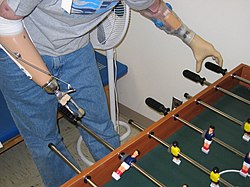Prosthesis

A prosthesis is a device made to replace a missing human body part. They are used by people who are missing body parts due to accidents, health problems (amputees) or being born without them. Originally, prostheses were simply pieces of wood (for example, wooden legs), but now they are made of lighter and stronger materials.
Currently available prostheses can help return mobility to those with transtibial (below the knee), transfemoral (above the knee), transradial (below the elbow), and transhumeral (above the elbow) amputations. There is still much research to be done before artificial limbs can function with the same versatility as a natural limb; as a result many of the currently available prosthetic limbs are tailored to a specific activity or need.
In sports
In Para-alpine skiing, the device needs to be made to work like an ankle because the way the ankle moves is very important in skiing. The device for skiing is only used in skiing. People use other prostheses when they are not skiing.[1]
Prosthetic arms can be designed for climbing as well. Private Jaco Van Gass, an amputee veteran, designed a special prosthetic arm with a built in ice pick that he would use to climb Mount Everest. It also includes a battery pack and heat patch to keep his stump warm. [2]
Olympic sprinter Oscar Pistorius also had prostheses designs specifically for spot. He used carbon fiber running blades that, some argue, give an advantage over natural legs.[3]
Underlying Mechanisms
A traditional prosthetic limb consists of three main components: a socket, an attachment mechanism, and a control system.
The socket is the part of the prosthetic that attaches to the users natural body. A precise fit is extremely important to the function of the limb, so typically molds are taken of a patient’s residual limb to ensure the fit is ideal. If it does not fit correctly, the socket could cause severe tissue damage to the patient.
The attachment mechanism is a means of securely anchoring the limb in a way that is both comfortable and easy for the user to control. The attachment mechanism may work by tension (straps) or even merely by suction between the socket and the limb.
The control system varies greatly from limb to limb. Some are controlled entirely by the user’s motion; he or she learns to balance on it. In other cases, cables are pulled to cause a limb to bend in the desired direction.
Today, the most promising control system is the myoelectric signal. This technology is allowing for thought-controlled prosthetics to be developed.[4]
Prosthesis Media
A factory worker with a prosthetic arm using a lathe to produce artificial limbs c. 1944
An example of two upper-extremity prosthetics, one body-powered (right arm), and another myoelectric (left arm)
A wooden prosthetic leg from Shengjindian cemetery, circa 300 BCE, Turpan Museum. This is "the oldest functional leg prosthesis known to date".
Brain control of 3D prosthetic arm movement (hitting targets). This movie was recorded when the participant controlled the 3D movement of a prosthetic arm to hit physical targets in a research lab.
References
- ↑ Ron Seymour (2002). Prosthetics and Orthotics: Lower Limb and Spinal. Lippincott Williams & Wilkins. pp. 293–295. ISBN 978-0-7817-2854-6. Retrieved 12 September 2013.
- ↑ "Amputee Veteran Designs Ice Axe Prosthetic to Help Climb Everest : Discovery News". Archived from the original on 2015-05-08. Retrieved 2015-08-18.
- ↑ "How Oscar Pistorius Runs". Live Science. 9 August 2012.
- ↑ "Prosthetics: A simple introduction to artificial limbs". Archived from the original on 2015-08-22. Retrieved 2015-08-18.
Other websites
![]() Media related to Prosthetics at Wikimedia Commons
Media related to Prosthetics at Wikimedia Commons









